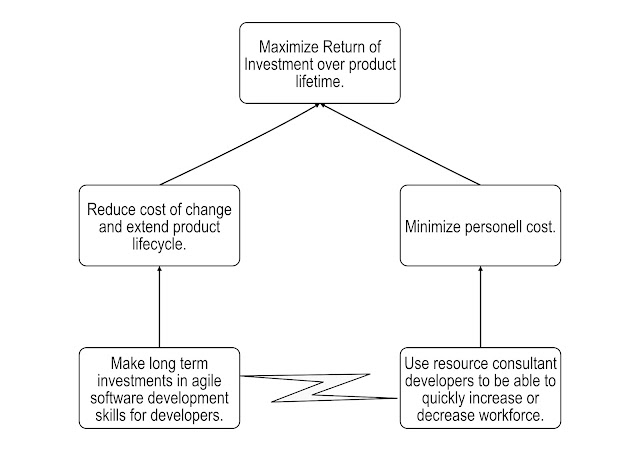Systems Archetype: Accidental Adversaries (The Road to Hell...)
There are many ways a relationship can go wrong, in business, and for individuals. The Accidental Adversaries systems archetype describes a common pattern, where a relationship begins with the best of intentions on both sides, but deteriorates over time. The pattern is quite complex, which makes it insidious and sometimes difficult to recognize. It looks like this:

What happens is that two parties, A and B, enter a relationship for mutual benefit. In the beginning, everything looks rosy, but then A takes some action that looks perfectly reasonable from A's perspective, but creates unintended difficulties for B. B then does something to recover from the consequences, and this affects A.
Often neither A nor B understands the effects their actions have on the other side. A sees only the undesired effects B's actions have on A. B sees only the undesired effects A's actions have on B. Pretty soon A and B begin to think of each other as stupid or evil. The downward spiral (The Eroding relationship loop in the figure above) can escalate until the relationship is dissolved, or turn former allies into bitter enemies.
One of our greatest assets work against us when we are caught in an Accidental Adversary pattern. Our brains are formidable pattern recognition engines. A human brain is also very adept at filling in unknown areas in patterns. Unless a conscious effort is made, the brain will go for the simplest explanation possible, from its own perspective. It is very easy to jump to the conclusion that the other side has some nefarious motive, when, in reality, both sides are guilty of the same thing: having a local point of view and limited range of vision and insight.
Once an unfavorable opinion (attribution error) of the other party has been formed, it can easily be cemented by confirmation bias, our tendency to interpret new data so that it confirms our current opinion. Our opinions do of course affect our behavior. If we no longer trust our ally, we are likely to take preventive measures in order to protect ourselves. The other side is then likely to interpret our actions as nefarious, which prompts them to protect themselves, turning our original attribution error into a self-fulfilling prophecy.
Halting the Downward Spiral
One way of resolving the conflict is to just let it run its course until the relationship dissolves. This is common in marriage, about one third end in divorce (in Sweden). It is also common in business. This has the advantage of not requiring anyone to make any mental effort. All people have to do is let their reptile brains take charge and react to the "evil" actions by the other side.
Emotionally satisfying as this may be, it has a couple of drawbacks. One is that it may weaken both sides, leaving them vulnerable to other dangers. Another, in my opinion the greatest, is that no one learns anything, and is liable to repeat the same mistakes in the future, with different allies.
On the other hand, if we choose to learn, choose to take positive action, and break the unfolding pattern, we will gain experience. This experience will be valuable not just because it saves the stressed relationship, but because it will help us recognize, prevent, and counter similar situations in the future.
Fixing the problem hinges on making both parties aware what is happening. If both parties agree to deal with the real problem you have a good chance of succeeding in dissolving the problem. Here is one way to do it:
- Raise your own awareness of the problem. Study the archetype and use it to figure out how your own actions have contributed to the deteriorating relationship. Make a conscious effort to understand how your actions have been interpreted by the other side.
- Open talks with the other side. Tell them that you want to restore the good relationship. Go back to the original reasons for having the relationship. Tell them up front about the archetype, and that you are trying to figure out how to fix your own end of the system. Ask the other side to help you with this by providing information about the problems you have caused. It is likely the other side will reciprocate by making a similar offer. It may take some time though, until they trust you to be serious. (If they do not, well, not all relationships are worth saving...)
- Build a map of the relationship, both benefits and undesired effects. You can use a Current Reality Tree (CRT) or Causal Loop Diagram to do this. I prefer the CRT, because it fits neatly with a complete toolkit for solving these kinds of problems, The Logical Thinking Process (TLTP). Pay particular attention to negative branch analysis when developing the CRT. (This means you must identify and include undesired effects, not just focus on what you want to happen.)
- Develop a map of overarching goals that unite the parties. I recommend you use an Intermediate Objective Map (IO Map) to do this. IO Maps, like CRTs, are part of the TLTP toolkit.
- Establish metrics (Key Performance Indicators, KPI) to monitor your collaborative behavior. Use the IO Map to figure out what metrics to use. Pay attention to finding KPIs that are leading indicators of problems. You may need to create low level IO Maps (process level) to do this.
- Establish communications protocols that ensure both sides get advance warning of what the other side is about to do.
- Build a high level road map for rebuilding the relationship. The road map must be developed jointly, and must include actions by both sides. A Future Reality Tree (FRT) is great for this. (You guessed it, FRTs are part of the TLTP toolkit.) The FRT will contain injections, very high level descriptions of intermediate objectives that must be achieved to restore and/or develop the relationship.
- If necessary, build more detailed work breakdown structures showing how to achieve the injections in the FRT. A Prerequisite Tree (PRT) is my preferred tool for this. You can use whatever method you or your company uses to create project plans. The idea is to create a plan containing concrete actions.
- Execute the plan you and your ally have made.
Of course, you can substitute whatever problem solving and project planning tools you or your organization uses. If you don't like fancy diagrams, try just talking things over with your accidental adversary. In order to succeed, you must first try.



Comments